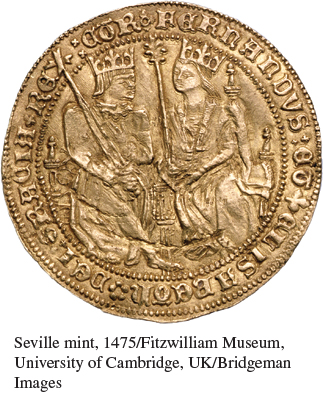A History of Western Society: Printed Page 386
A History of Western Society, Concise Edition: Printed Page 386
Evaluating the Evidence 12.3
Page 386
A Gold Coin of Ferdinand and Isabella
Minting coins provided a way for Renaissance monarchs to enhance their economies and also to show royal might and communicate other messages. This large gold coin, known as the “double excelente,” was issued by the Seville mint in 1475, one year after Isabella had become queen in her own right of Castile and Ferdinand had become king because he was her husband. (Ferdinand would become king of Aragon in 1479 when his father died.) The eagle on the reverse holds both their coats of arms.


(photos: Seville mint, 1475/Fitzwilliam Museum, University of Cambridge, UK/Bridgeman Images)
EVALUATE THE EVIDENCE
- What symbols of power are shown with the monarchs on the coin? How does the coin convey the fact that their marriage was the union of two rulers?
- Rulers sometimes stipulated that all major transactions within their realms be carried out with certain coins, much the same way governments today allow only the national currency. What was their aim in doing this, and why might such policies have been hard to enforce?